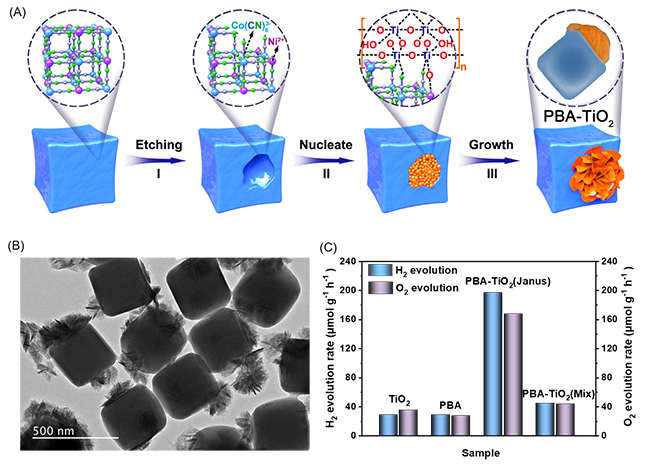Janus Nanoreactor Designed for Bifunction of Photocatalytic Water Oxidation/reduction
Janus structure is composed of two or more components with different (usually opposite) physical and chemical properties. Janus nanoparticles possess multiple surface structures that are anisotropic in shape, composition, and surface chemistry.
Janus nanoreactors have been applied in the fields like catalysis, biomedicine, as well as energy storage and conversion. However, it remains a challenge to construct Janus nanoreactors with stable interfacial structure.
Recently, a research team led by Prof. LIU Jian from the Dalian Institute of Chemical Physics (DICP) of the Chinese Academy of Sciences, in collaboration with Prof. HU Ming from East China Normal University, reported a novel and simple strategy for the synthesis of dual-component Janus nanoreactor with asymmetric structure to realize bifunction of photocatalytic water oxidation/reduction.
This work was published in Advanced Science on Feb. 16.

A: schematic illustration of the synthetic strategy for the PBA–TiO2 Janus nanoreactor, B: TEM images of the as-prepared PBA-TiO2 Janus nanoreactors C: comparison of photocatalytic H2 evolution and O2 evolution rate of TiO2, PBA, PBA–TiO2 Janus nanoreactors and PBA–TiO2 (mix) samples under light irradiation ( Image by SHI Chunjing)
"We mimics the concepts of compartmentalization used by nature to design PBA-TiO2 Janus photocatalysts for coordinating incompatible chemical transformations," said Prof. LIU.
In the synthesis process, the partial dissociation of the PBA cube was induced by mild etching. The unsaturated metal sites on the PBAs could form the chemical bond with oxygen ions and Ti4+, inducing heterogeneous nucleation of TiOx on the surface of the PBA single crystals.
Free-standing flowers assembled by TiO2 nanoflakes took root in the PBA single crystals. The PBA-TiO2 Janus nanoreactor gradually emerged and the asymmetric dual-components of nanoreactor possessed a synergistic effect due to the presence of the interfacial structure.
The forming interfacial structure could promote the fast charge transport and effectively inhibit the photogenerated electron and hole recombination. The photocatalytic activity of PBA-TiO2 Janus nanoreactor for water oxidation/reduction was significantly higher than that of pure TiO2 and PBA catalysts.
The above work was supported by the National Natural Science Foundation of China, and Dalian National Laboratory for Clean Energy (DNL) Cooperation Fund, Chinese Academy of Sciences. (Text by SHI Chunjing)